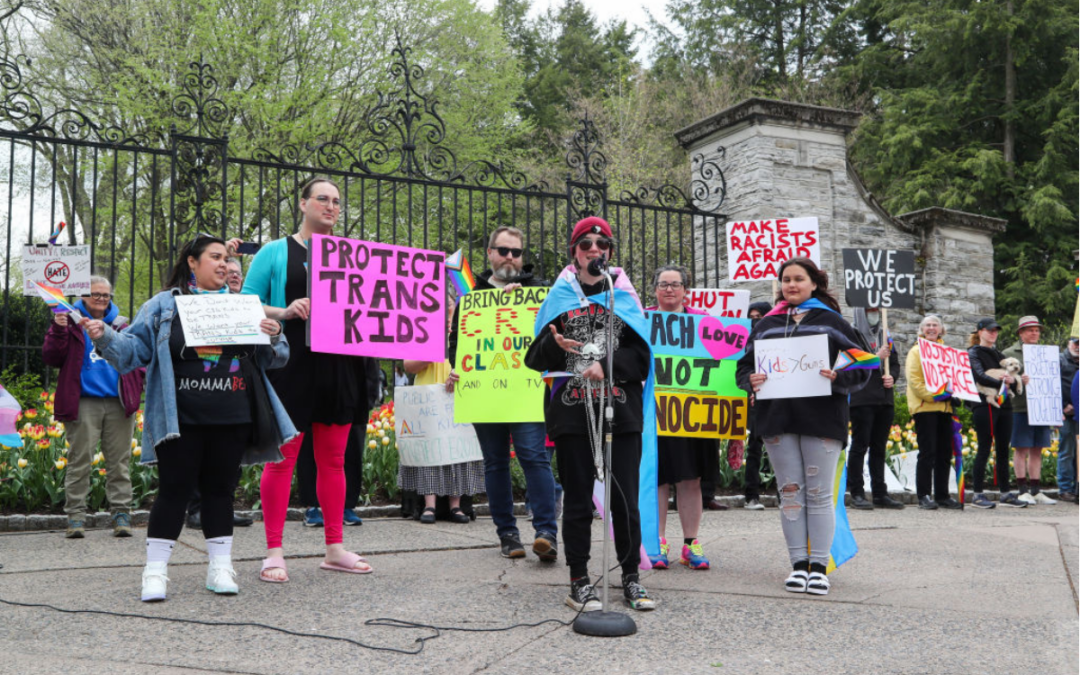
The city of Pottsville, Pa., is surrounded by smoke and haze from Canadian wildfires on Tuesday evening, June 6, 2023. (Jacqueline Dormer/ Republican-Herald via AP)
A code red has been issued in Pennsylvania, as intense Canadian wildfires are causing serious air quality issues throughout the state.
A blanket of haze and the smell of campfire blanketed Pennsylvania Tuesday due to intense Canadian wildfires hundreds of miles to the north. Conditions are expected to continue through Wednesday and possibly into Thursday, according to meteorologists.
The wildfires have turned the air acrid and the sky yellowish gray, blotting out skylines in some places and irritating throats. The air quality for the commonwealth was code red as of Wednesday afternoon, with the state Department of Environmental Protection cautioning all residents to limit outdoor activity and vulnerable populations to stay inside.
Authorities have issued air quality alerts elsewhere. Hazy conditions and smoke from the wildfires were reported across the Great Lakes region from Cleveland to Buffalo, along with New York state and New England.
A smoky haze that hung over New York City much of the day Tuesday thickened in the late afternoon, obscuring views of New Jersey across the Hudson River and making the setting sun look like a reddish orb. In the Philadelphia area, dusk brought more of a lavender haze.
Smoke from the fires has wafted through northeast US states for weeks now, but it’s only recently been noticeable in most places.
Here’s a closer look at what’s happening and some suggested precautions for dealing with the haze:
What’s Happening?
Smoke from Canada’s wildfires has been moving into the United States since last month. The most recent fires near Quebec have been burning for at least several days.
The US Environmental Protection Agency said hazy skies, reduced visibility and the odor of burning wood are likely, and that the smoke will linger for a few days in northern states.
“It’s not unusual for us to get fire smoke in our area. It’s very typical in terms of northwest Canada,” said Darren Austin, a meteorologist and senior air quality specialist with the Rhode Island Department of Environmental Management. But, usually, the smoke has been aloft and hasn’t affected people’s health, he said.
The Quebec-area fires are big and relatively close, about 500 to 600 miles (roughly 800 to 970 kilometers) away from Rhode Island. And they followed wildfires in Nova Scotia, which resulted in a short-lived air quality alert on May 30, Austin said.
Jay Engle, a National Weather Service meteorologist based in Upton, Long Island, said the wind trajectory that allowed smoke and hazy conditions to be seen in the New York City area could continue for the next few days. Of course, he said, the main driver of conditions is the fires themselves. If they diminish, the haze would too.
What’s the Biggest Concern?
Air quality alerts are triggered by a number of factors, including the detection of fine-particle pollution — known as “PM 2.5” — which can irritate the lungs.
“We have defenses in our upper airway to trap larger particles and prevent them from getting down into the lungs. These are sort of the right size to get past those defenses,” said Dr. David Hill, a pulmonologist in Waterbury, Connecticut, and a member of the American Lung Association’s National Board of Directors. “When those particles get down into the respiratory space, they cause the body to have an inflammatory reaction to them.”
Trent Ford, the state climatologist in Illinois, said the atmospheric conditions in the upper Midwest creating dry, warm weather made it possible for small particles to travel hundreds of miles from the Canadian wildfires and linger for days.
“It’s a good example of how complex the climate system is but also how connected it is,” Ford said.
Who Should Be Careful?
Exposure to elevated fine particle pollution levels can affect the lungs and heart.
The air quality alerts caution “sensitive groups,” a big category that includes children, older adults, and people with lung diseases, such as asthma and chronic obstructive pulmonary disease.
Kids, who often are encouraged to go out and play, “are more susceptible to smoke for a number of reasons,” said Laura Kate Bender, the lung association’s National Assistant Vice President, healthy air. “Their lungs are still developing, they breathe in more air per unit of body weight.”
What Can You Do For Now?
It’s a good time to put off that yard work and outdoor exercise. If you go out, consider wearing an N95 mask to reduce your exposure to pollutants.
Stay inside, keeping your doors, windows and fireplaces shut. It’s recommended that you run the air conditioning on a recirculation setting.
“If you have filters on your home HVAC system, you should make sure they’re up to date and high quality,” Hill said. “Some people, particularly those with underlying lung disease, or heart disease, should consider investing in air purifiers for their homes.”
Information From the Associated Press was used in this report.
Support Our Cause
Thank you for taking the time to read our work. Before you go, we hope you'll consider supporting our values-driven journalism, which has always strived to make clear what's really at stake for Pennsylvanians and our future.
Since day one, our goal here at The Keystone has always been to empower people across the commonwealth with fact-based news and information. We believe that when people are armed with knowledge about what's happening in their local, state, and federal governments—including who is working on their behalf and who is actively trying to block efforts aimed at improving the daily lives of Pennsylvania families—they will be inspired to become civically engaged.


For Rep. Susan Wild, supporting PA families includes reproductive rights and much more
Rep. Susan Wild wants to be very clear with Pennsylvanians: Donald Trump is committed to taking away women’s reproductive freedom, but he is not...

School districts working with anti-LGBTQ groups can cost your kids’ schools millions
Parents across South Central Pennsylvania are worried about the potential financial impacts working with anti-LGBTQ groups may have on their school...

VIDEO: Trump distances himself from his anti-abortion views
Donald Trump appeared on WGAL on Tuesday and continued to distance himself from his anti-abortion views claiming that reproductive rights are now a...

VIDEO: Community pushback gets school board to rescind decision on denying gay actor’s visit
Cumberland Valley School Board offered a public apology and voted to reinstate Maulik Pancholy as a guest speaker a week after the board voted to...

VIDEO: Project 2025 brings nuclear armageddon back into vogue
Project 2025 is a titanic document, with plans ranging from cutting half of all government employees to targeting reproductive rights on a scale...





